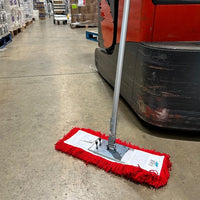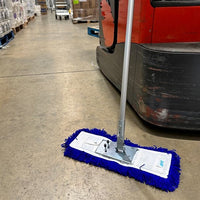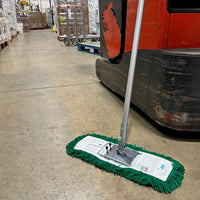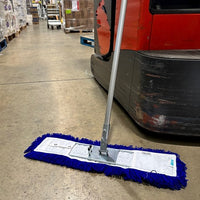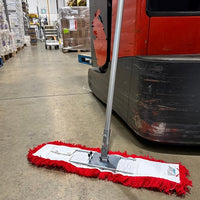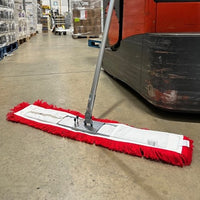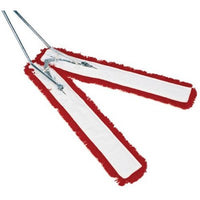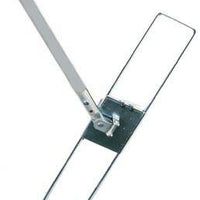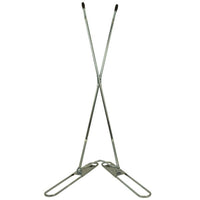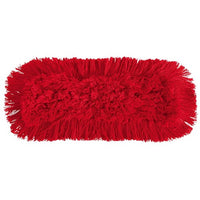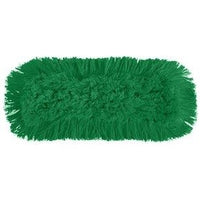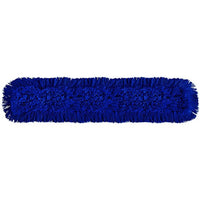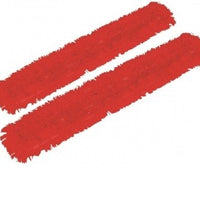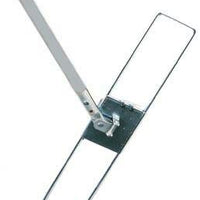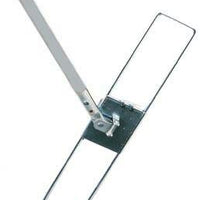Collection: Floor Sweepers
Discover our comprehensive range of professional floor sweepers designed for efficient cleaning of hard floor surfaces subject to high levels of dry traffic, dust, and spillage. Perfect for dining halls, theatre lobbies, hotel reception areas, and commercial spaces, our floor sweepers from leading brand SYR offer cost-effective, washable solutions that make excellent additions to any janitorial cupboard. Our collection includes dust control sweepers in multiple sizes (16"/40cm, 24"/60cm, 32"/80cm), colour-coded options in red, blue, and green for contamination control, innovative V-sweeper systems for large area cleaning, and comprehensive replacement parts including washable sleeves and frames. These low-maintenance, high-efficiency cleaning tools provide superior dust collection and debris removal whilst remaining economical and environmentally responsible through their washable, reusable design.
Floor Sweepers Product information
Floor sweepers are ideal for hard floor surfaces which are subject to a high level of dry traffic, dust and snack spillage, making them ideal for dining halls, theatre and hotel lobbies. They are a low-cost, washable tool which make a great addition to any janitorial cupboard.
Effective floor sweeping requires understanding the relationship between surface conditions, debris characteristics, and cleaning requirements. Modern floor sweeper technology combines traditional dust collection principles with advanced materials and ergonomic design to deliver superior cleaning performance whilst addressing efficiency, sustainability, and operational cost concerns across diverse commercial environments.
At ClickCleaning, we provide comprehensive floor sweeper solutions designed to meet varied cleaning requirements across all commercial applications. Our carefully selected range includes SYR Dust Control Sweepers in 16"/40cm, 24"/60cm, and 32"/80cm sizes, available in red, blue, and green colour-coding for contamination control, innovative V-Sweeper systems for large area cleaning, comprehensive replacement sleeves and frames, and professional-grade components that ensure reliable performance across demanding applications.
The selection of appropriate floor sweepers depends on understanding area size, traffic patterns, and debris characteristics. Smaller sweepers excel in confined spaces and detailed cleaning, whilst larger sweepers provide efficiency for extensive area coverage. Colour-coding systems support hygiene
protocols by preventing cross-contamination between different cleaning zones.
SYR Dust Control Sweeper Technology
SYR dust control sweepers represent advanced cleaning technology engineered to provide efficient debris collection whilst maintaining superior dust control characteristics. The innovative design combines traditional sweeping effectiveness with modern dust capture capabilities for comprehensive floor
maintenance.
16"/40cm Dust Control Sweepers
The 16"/40cm dust control sweeper provides optimal balance between manoeuvrability and cleaning effectiveness for medium-sized areas and detailed cleaning applications. This compact size enables efficient cleaning around furniture, fixtures, and obstacles whilst maintaining superior dust collection
performance.
Available in red, blue, and green colour-coding, these sweepers support professional hygiene systems that prevent cross-contamination between different cleaning areas. The colour-coding system ensures cleaning equipment used in one area never comes into contact with other areas where contamination could spread.
Red designation typically indicates high-risk areas including toilets, washrooms, and sanitary facilities. The dedicated red equipment prevents contamination transfer whilst providing effective cleaning action for challenging hygiene applications.
Blue designation represents general cleaning areas including offices, reception spaces, and public areas. The dedicated blue equipment ensures contamination control whilst providing effective cleaning performance for routine maintenance tasks.
Green designation indicates food preparation and kitchen areas where maintaining hygiene standards is paramount. The dedicated green equipment ensures contamination cannot transfer from other areas to food preparation zones, supporting HACCP compliance.
The dust control system incorporates advanced fibre technology that captures and retains fine particles whilst preventing dust dispersal during cleaning operations. This capability maintains air quality whilst providing thorough surface cleaning.
24"/60cm Dust Control Sweepers
The 24"/60cm dust control sweeper extends cleaning efficiency to larger areas whilst maintaining the manoeuvrability necessary for commercial cleaning applications. This intermediate size provides excellent coverage for corridors, lobbies, and medium-sized spaces.
Available in blue and red colour-coding, these sweepers maintain contamination control benefits whilst providing enhanced productivity for area cleaning. The increased width significantly reduces cleaning time whilst maintaining dust control effectiveness.
Ergonomic design features include balanced weight distribution and comfortable handle positioning that reduces operator fatigue during extended cleaning sessions. The construction supports efficient cleaning whilst maintaining operator comfort.
Enhanced dust capture capability results from the increased surface area and advanced fibre technology that provides superior particle retention. The system maintains air quality whilst delivering thorough cleaning performance.
32"/80cm Dust Control Sweepers
The 32"/80cm dust control sweeper provides maximum efficiency for large area cleaning applications whilst maintaining the dust control characteristics essential for commercial environments. This size optimises productivity for extensive spaces including dining halls, hotel lobbies, and large reception areas.
Available in red colour-coding, these sweepers provide contamination control benefits whilst delivering maximum cleaning efficiency. The substantial width enables rapid cleaning of extensive areas whilst maintaining dust control effectiveness.
Professional construction includes reinforced components that withstand demanding commercial use whilst maintaining cleaning performance. The robust
design ensures reliable operation under intensive cleaning conditions.
Maximum dust control capability results from the extensive surface area and advanced fibre technology that provides comprehensive particle capture across large areas. The system maintains air quality whilst delivering efficient cleaning performance.
V-Sweeper Systems for Large Area Cleaning
V-sweeper systems represent innovative cleaning technology designed for rapid, efficient cleaning of large areas through unique scissor-action design that maximises coverage whilst maintaining superior dust control characteristics.
SYR Red V-Sweeper Dust Control Mop
The SYR Red V-Sweeper provides revolutionary cleaning capability for large areas through its adjustable scissor-action design that extends up to 5 feet wide for maximum sweeping efficiency. This innovative system enables rapid cleaning of extensive areas whilst maintaining dust control effectiveness.
The V-shaped configuration utilises two mop heads that work simultaneously to provide comprehensive cleaning coverage. The scissor action allows
adjustment of the sweeping width to match area requirements and operator preferences.
Static electricity generation within the synthetic fibres attracts and retains dust particles without requiring chemical treatments. This natural dust attraction capability provides effective cleaning whilst maintaining environmental responsibility.
Machine washable construction enables thorough cleaning and sanitisation of the mop heads, extending product life whilst maintaining hygiene standards. The washable capability reduces operating costs whilst supporting sustainability initiatives.
Ergonomic soft-grip handles provide comfortable operation during extended cleaning sessions whilst maintaining precise control over sweeping action. The handle design reduces operator fatigue whilst ensuring effective cleaning performance.
Professional applications include large dining areas, hotel lobbies, conference facilities, and any environment requiring rapid cleaning of extensive floor areas. The system provides efficiency advantages over traditional sweeping methods.
V-Sweeper Components and Replacement Parts
The V-sweeper system includes comprehensive replacement components that ensure continued performance whilst maintaining cost-effectiveness through
replaceable parts rather than complete unit replacement.
V-sweeper frames provide the structural foundation for the scissor-action system, incorporating precision engineering that ensures smooth operation and reliable performance. The aluminium construction provides durability whilst remaining lightweight for operator comfort.
V-sweeper mop heads utilise advanced synthetic materials that generate static electricity for dust attraction whilst maintaining durability through multiple wash cycles. The specialized fibre construction provides superior cleaning effectiveness.
Replacement intervals depend on usage intensity and maintenance practices, with typical commercial applications requiring replacement every 6-12 months depending on cleaning frequency and environmental conditions.
Colour-Coded Hygiene Systems
Colour-coded floor sweeper systems provide essential contamination control by ensuring cleaning equipment used in one area never comes into contact with other areas where cross-contamination could occur.
Professional Hygiene Protocols
The standard colour-coding system follows established hygiene protocols that prevent dangerous cross-contamination scenarios whilst maintaining cleaning effectiveness across all areas.
Red equipment designation prevents contamination transfer from high-risk areas including toilets, washrooms, and sanitary facilities. Equipment used in
these areas must never be used in food preparation or general cleaning areas.
Blue equipment designation ensures general cleaning areas including offices, reception spaces, and public areas maintain appropriate hygiene standards
whilst preventing contamination from high-risk areas.
Green equipment designation maintains food preparation and kitchen area hygiene by ensuring equipment remains dedicated to food-safe environments. This prevents contamination transfer from non-food areas.
Implementation requires comprehensive staff training that ensures all personnel understand which colours belong in which areas and why the system matters for health and safety. The visual system eliminates confusion when properly implemented.
Contamination Prevention Benefits
Cross-contamination prevention represents the primary benefit of colour-coded systems, ensuring harmful bacteria and pathogens cannot transfer between different areas through cleaning equipment.
Food safety compliance becomes achievable through systematic colour-coding that prevents contamination between food preparation areas and other spaces. This supports HACCP requirements and regulatory compliance.
Healthcare applications benefit from colour-coding that prevents infection transfer between patient areas and general spaces. The system supports
infection control protocols whilst maintaining cleaning effectiveness.
Educational facilities utilise colour-coding to maintain appropriate hygiene standards across diverse areas including classrooms, food service areas, and
sanitary facilities.
Washable Sleeve Technology
Washable sleeve technology represents sustainable cleaning solutions that provide cost-effectiveness whilst maintaining superior cleaning performance
through reusable components.
Advanced Fibre Construction
Washable sleeves utilise specially engineered synthetic fibres that provide dust attraction capabilities whilst maintaining durability through multiple wash cycles. The fibre construction balances cleaning effectiveness with longevity.
Static electricity generation occurs naturally within the synthetic fibres, attracting and retaining dust particles without requiring chemical treatments.
This provides effective cleaning whilst maintaining environmental responsibility.
Absorption characteristics include both dry dust capture and light moisture management, enabling versatile cleaning applications across different surface
conditions and debris types.
Durability testing ensures sleeves maintain cleaning effectiveness through minimum 100 wash cycles under normal commercial use conditions. This longevity provides cost-effectiveness whilst supporting sustainability initiatives.
Maintenance and Care Procedures
Proper maintenance significantly extends sleeve life whilst ensuring consistent cleaning performance throughout the service period. Regular maintenance procedures support both performance and cost-effectiveness.
Washing procedures include machine washing at temperatures up to 60°C using standard detergents without fabric softeners that could reduce static
electricity generation. Proper washing maintains cleaning effectiveness whilst ensuring hygiene.
Drying requirements specify air drying or low-heat tumble drying to prevent fibre damage whilst maintaining static electricity generation capabilities.
Proper drying ensures continued cleaning effectiveness.
Storage considerations include clean, dry conditions that prevent contamination whilst maintaining fibre integrity. Proper storage extends sleeve life whilst ensuring readiness for use.
Replacement indicators include reduced cleaning effectiveness, visible fibre damage, or inability to generate static electricity. Replace sleeves when
performance declines regardless of visual appearance.
Commercial Applications and Environments
Floor sweepers provide essential cleaning capability across diverse commercial environments, each presenting unique challenges and requirements for
effective dust control and debris removal.
Hospitality Industry Applications
Hotel lobbies require rapid, efficient cleaning that maintains pristine appearance whilst minimising disruption to guests. Floor sweepers provide quiet, effective cleaning that supports hospitality standards.
Dining areas benefit from frequent cleaning that removes food debris and maintains hygiene standards whilst operating during service periods. The washable technology supports frequent cleaning without operational disruption.
Conference facilities utilise floor sweepers for rapid cleaning between events, maintaining professional appearance whilst supporting tight scheduling requirements.
Guest corridors require regular cleaning that maintains appearance whilst operating quietly to avoid guest disturbance. The dust control capabilities maintain air quality whilst providing effective cleaning.
Educational Facility Applications
School corridors experience high traffic volumes that generate significant dust and debris, requiring efficient cleaning that maintains safe, clean environments whilst supporting tight operational schedules.
Dining halls require frequent cleaning that maintains hygiene standards whilst accommodating rapid turnover between meal periods. The colour-coded
systems support food safety requirements.
Assembly areas benefit from rapid cleaning that maintains appearance whilst supporting diverse activities and events. The large area capabilities provide efficiency for extensive spaces.
Classroom cleaning requires quiet, efficient operation that maintains learning environments whilst supporting diverse educational activities.
Healthcare Facility Applications
Hospital corridors require cleaning that maintains hygiene standards whilst supporting infection control protocols. The colour-coded systems prevent
cross-contamination between patient areas and general spaces.
Waiting areas benefit from frequent cleaning that maintains appearance whilst supporting patient comfort and safety. The dust control capabilities maintain air quality for patient wellbeing.
Treatment areas require specialized cleaning that maintains sterile conditions whilst supporting diverse medical procedures. The washable technology supports strict hygiene requirements.
Retail Environment Applications
Shopping centres require cleaning that maintains appearance whilst accommodating continuous customer traffic. The efficient cleaning capabilities
support operational requirements whilst maintaining professional appearance.
Restaurant areas benefit from frequent cleaning that maintains hygiene standards whilst supporting food service operations. The colour-coded systems
support food safety requirements.
Office buildings require cleaning that maintains professional appearance whilst supporting diverse business activities. The dust control capabilities
maintain air quality for employee wellbeing.
Operational Efficiency and Cost-Effectiveness
Floor sweepers provide significant operational advantages over traditional cleaning methods whilst delivering superior results and cost-effectiveness
across diverse commercial applications.
Time Efficiency Benefits
Rapid cleaning capability enables coverage of large areas in minimal time, reducing labour costs whilst maintaining cleaning effectiveness. The efficiency
advantages support tight operational schedules.
Reduced cleaning frequency results from superior dust control that maintains clean conditions for extended periods. This reduces labour requirements whilst maintaining appearance standards.
Immediate use capability eliminates drying time required with wet cleaning methods, enabling continuous facility operation whilst maintaining cleaning
effectiveness.
Labour Cost Reduction
Single-operator efficiency enables one person to clean areas that would require multiple personnel using traditional methods. This provides significant
labour cost savings whilst maintaining cleaning quality.
Reduced training requirements result from intuitive operation that requires minimal instruction for effective use. This supports operational efficiency whilst maintaining cleaning standards.
Extended operational periods result from durable construction that withstands intensive commercial use whilst maintaining performance. This reduces replacement costs whilst ensuring continued effectiveness.
Environmental Sustainability
Washable components eliminate disposable cleaning materials, reducing waste generation whilst maintaining cleaning effectiveness. This supports
environmental responsibility whilst providing cost savings.
Chemical-free operation eliminates cleaning solution requirements, reducing environmental impact whilst maintaining cleaning effectiveness. This supports sustainability initiatives whilst reducing operational costs.
Reduced packaging waste results from reusable components that eliminate frequent replacement requirements. This supports environmental responsibility
whilst providing cost-effectiveness.
Professional Maintenance and Support
Proper maintenance ensures continued performance whilst maximising equipment life and maintaining cost-effectiveness across commercial applications.
Preventive Maintenance Procedures
Regular cleaning of sweeper components removes accumulated debris whilst maintaining operational effectiveness. Proper maintenance prevents performance degradation whilst extending equipment life.
Inspection procedures identify wear patterns and replacement needs before performance degradation occurs. This maintains cleaning effectiveness whilst
preventing operational disruption.
Lubrication requirements for moving parts ensure smooth operation whilst preventing premature wear. Proper lubrication maintains performance whilst
extending equipment life.
Replacement Part Availability
Comprehensive replacement parts ensure continued operation whilst maintaining cost-effectiveness through component replacement rather than complete unit replacement.
Sleeve replacement provides continued cleaning effectiveness whilst maintaining cost-effectiveness. Regular replacement ensures optimal performance whilst supporting operational requirements.
Frame replacement addresses wear and damage whilst maintaining system integrity. Quality replacement parts ensure continued performance whilst
supporting long-term use.
Handle replacement accommodates wear and operator preferences whilst maintaining ergonomic benefits. Proper replacement ensures continued comfort
whilst maintaining cleaning effectiveness.
Whether you're maintaining hotel lobbies, cleaning dining facilities, managing educational environments, or ensuring healthcare facility cleanliness,
ClickCleaning's floor sweeper range provides the performance, efficiency, and reliability necessary for superior cleaning results across all commercial
applications.
Please contact us if you have any questions about our range we can assist with.
Floor Sweepers FAQs
What's the difference between a floor sweeper and a traditional broom?
The fundamental differences between floor sweepers and traditional brooms lie in their cleaning mechanism, efficiency, and dust control capabilities, with floor sweepers offering significant advantages for commercial applications.
Floor sweepers utilise advanced synthetic fibres that generate static electricity to attract and retain dust particles, providing superior dust collection compared to traditional brooms that often redistribute dust into the air. This static attraction capability ensures thorough cleaning whilst maintaining air quality during cleaning operations.
Coverage efficiency is dramatically improved with floor sweepers, particularly V-sweeper systems that can extend up to 5 feet wide, enabling rapid cleaning of large areas. Traditional brooms require multiple passes and more time to achieve similar coverage, making floor sweepers significantly more efficient for commercial applications.
Dust control represents a crucial advantage, as floor sweepers capture and retain fine particles that traditional brooms would scatter into the air. This capability maintains air quality whilst providing thorough surface cleaning, making floor sweepers ideal for environments where dust control is critical.
Washable construction enables repeated cleaning and sanitisation of floor sweeper components, extending product life whilst maintaining hygiene standards. Traditional brooms typically require replacement when contaminated or worn, making floor sweepers more cost-effective over time.
Ergonomic design reduces operator fatigue during extended cleaning sessions through balanced weight distribution and comfortable handle positioning. Traditional brooms often cause strain during extended use, whilst floor sweepers are designed for comfort during commercial applications.
Professional applications favour floor sweepers for their efficiency, dust control, and cost-effectiveness in commercial environments where cleaning quality and speed are essential. Traditional brooms may be suitable for light domestic use but cannot match the performance advantages of floor sweepers in professional settings.
How do I choose the right size floor sweeper for my facility?
Selecting the appropriate floor sweeper size requires careful consideration of area dimensions, obstacle density, and cleaning requirements to ensure optimal performance and efficiency.
Small areas (16"/40cm sweepers) are ideal for confined spaces, areas with numerous obstacles, and detailed cleaning applications. These compact sweepers provide excellent manoeuvrability around furniture, fixtures, and equipment whilst maintaining effective cleaning performance.
Medium areas (24"/60cm sweepers) offer optimal balance between coverage and manoeuvrability for most commercial applications. These intermediate sizes provide good efficiency for corridors, lobbies, and medium-sized spaces whilst
remaining manageable for extended use.
Large areas (32"/80cm sweepers) maximise efficiency for extensive spaces including dining halls, hotel lobbies, and large reception areas. These sizes provide rapid cleaning capability for substantial floor areas whilst maintaining dust control effectiveness.
Obstacle density affects size selection significantly. Areas with numerous furniture pieces, equipment, or fixtures require smaller sweepers for effective manoeuvrability. Open areas with minimal obstacles can benefit from larger sweepers for maximum efficiency.
Cleaning frequency influences size selection. Areas requiring frequent cleaning may benefit from larger sweepers for efficiency, whilst areas needing occasional detailed cleaning might require smaller sweepers for thoroughness.
Storage space considerations may limit practical size options. Larger sweepers require more storage space and may not fit in confined cleaning cupboards or equipment areas.
Operator capability should be considered, as larger sweepers require more physical effort, especially when dealing with heavy debris loads. Consider who will be using the equipment and their physical capabilities.
Traffic patterns affect optimal size selection. Areas with consistent traffic flow may benefit from larger sweepers for efficiency, whilst areas with variable traffic patterns might require smaller sweepers for flexibility.
What makes SYR floor sweepers different from other brands?
SYR floor sweepers incorporate distinctive features and technologies that differentiate them from competitors whilst providing superior performance and value for commercial applications.
Advanced dust control technology sets SYR sweepers apart through sophisticated fibre engineering that maximises static electricity generation for superior dust attraction and retention. This technology provides more effective cleaning whilst maintaining air quality during operations.
Colour-coded contamination control systems demonstrate SYR's commitment to professional hygiene standards by providing visual identification systems that prevent cross-contamination between different cleaning areas. This systematic approach supports HACCP compliance and regulatory requirements.
Washable sleeve technology represents environmental responsibility and cost-effectiveness through reusable components that maintain cleaning effectiveness through multiple wash cycles. This sustainable approach reduces operational costs whilst supporting environmental initiatives.
Ergonomic design features include balanced weight distribution, comfortable handle positioning, and intuitive operation that reduces operator fatigue whilst maintaining cleaning effectiveness. These design elements support extended use in commercial applications.
Professional-grade construction utilises quality materials and precision manufacturing that ensure reliable performance under demanding commercial conditions. The robust construction provides longevity whilst maintaining cleaning effectiveness.
Innovation history includes continuous development of cleaning technology that addresses evolving commercial cleaning requirements. SYR's commitment to innovation ensures products remain current with industry needs.
Comprehensive support includes availability of replacement parts, technical assistance, and ongoing product development that ensures continued performance throughout the equipment life cycle.
Value proposition combines competitive pricing with superior performance and durability, providing excellent return on investment for commercial cleaning applications.
How do I maintain my floor sweeper sleeves for maximum lifespan?
Proper maintenance of floor sweeper sleeves significantly extends their lifespan whilst ensuring consistent cleaning performance throughout their service life.
Daily maintenance begins with removing debris from sleeves after each use. Shake out accumulated dust and debris, and inspect for damage or excessive wear that might affect performance.
Regular washing is essential for maintaining cleaning effectiveness and hygiene standards. Machine wash sleeves at temperatures up to 60°C using standard detergents without fabric softeners that could reduce static electricity generation.
Proper drying procedures include air drying or low-heat tumble drying to prevent fibre damage whilst maintaining static electricity generation capabilities. Avoid high heat that could damage synthetic fibres.
Storage considerations include clean, dry conditions that prevent contamination whilst maintaining fibre integrity. Store sleeves in ventilated areas away from direct sunlight and extreme temperatures.
Inspection procedures should identify wear patterns, fibre damage, or reduced cleaning effectiveness that indicates replacement needs. Regular inspection prevents performance degradation whilst maintaining cleaning quality.
Rotation systems for multiple sleeves can extend overall lifespan by reducing wear on individual components. Having spare sleeves enables continued operation whilst others are being cleaned.
Contamination prevention includes avoiding contact with sharp objects, aggressive chemicals, or substances that could damage fibres or reduce cleaning effectiveness.
Usage guidelines specify appropriate applications for different sleeve types and avoiding use beyond their designed capabilities. Proper use prevents premature wear whilst maintaining performance.
Replacement timing should be based on performance rather than appearance. Replace sleeves when cleaning effectiveness declines, regardless of visual condition.
Are colour-coded floor sweepers necessary for my business?
The necessity of colour-coded floor sweepers depends on your specific business type, hygiene requirements, and regulatory compliance needs, though most commercial operations benefit from contamination control systems.
Food service operations typically require colour-coded systems to comply with HACCP requirements and food safety regulations. The visual identification system prevents cross-contamination between food preparation areas and other
spaces.
Healthcare facilities benefit significantly from colour-coded systems that support infection control protocols by preventing contamination transfer between patient areas and general spaces. This systematic approach reduces infection risks whilst maintaining cleaning effectiveness.
Educational facilities often implement colour-coded systems to maintain appropriate hygiene standards across diverse areas including classrooms, food service areas, and sanitary facilities. The system supports health and safety requirements whilst maintaining cleaning effectiveness.
Hospitality businesses may choose colour-coded systems to demonstrate commitment to cleanliness standards whilst supporting operational efficiency. The visual system prevents contamination whilst maintaining guest confidence.
Regulatory compliance may require colour-coded systems for certain industries or applications. Check relevant regulations for your specific business type to determine requirements.
Insurance considerations may favour colour-coded systems that demonstrate commitment to contamination control and risk management. Some insurance providers recognise systematic approaches to hygiene management.
Cost-benefit analysis should consider both the initial investment in colour-coded systems and the long-term benefits of contamination prevention, regulatory compliance, and operational efficiency.
Staff training requirements include ensuring all personnel understand the colour-coding system and its importance for health and safety. The visual system simplifies training whilst ensuring compliance.
Quality assurance benefits include demonstrable commitment to hygiene standards that supports customer confidence and regulatory compliance.
How do V-sweeper systems work and when should I use them?
V-sweeper systems utilise innovative scissor-action design that enables efficient cleaning of large areas through adjustable width capability and dual-head cleaning action.
Operating mechanism involves two mop heads connected by a scissor-action frame that allows adjustment of the sweeping width from compact storage size to maximum 5-foot coverage. This adjustability enables operators to match cleaning width to area requirements.
Static electricity generation occurs naturally within the synthetic fibres of both mop heads, attracting and retaining dust particles without requiring chemical treatments. This dual-head static attraction provides comprehensive cleaning coverage.
Optimal applications include large open areas such as dining halls, hotel lobbies, conference facilities, and any environment requiring rapid cleaning of extensive floor space. The system provides efficiency advantages over traditional sweeping methods.
Efficiency benefits include significantly reduced cleaning time for large areas through maximum coverage capability. The dual-head action and adjustable width enable rapid cleaning that would require multiple passes with traditional equipment.
Manoeuvrability features include the ability to adjust width for navigation around obstacles whilst maintaining cleaning effectiveness. The scissor action enables adaptation to varying space requirements.
Dust control capabilities remain effective across the full width range through the dual-head design that maintains static electricity generation regardless of adjustment position.
Maintenance requirements include regular cleaning of mop heads and inspection of the scissor mechanism for smooth operation. Proper maintenance ensures continued performance whilst extending equipment life.
Surface compatibility includes all hard floor surfaces commonly found in commercial environments. The synthetic fibres provide effective cleaning without surface damage.
Cost considerations include higher initial investment compared to standard sweepers, but significant labour savings through increased efficiency for large area cleaning applications.
What types of debris can floor sweepers handle effectively?
Floor sweepers are designed to handle specific types of debris effectively, with performance varying based on debris characteristics and sweeper design features.
Fine dust particles represent the primary strength of floor sweepers, with static electricity generation providing superior attraction and retention of microscopic particles that traditional brooms would scatter into the air.
Light debris including paper fragments, food crumbs, and small particles are effectively captured through the combination of static attraction and fibre design that traps materials within the sleeve structure.
Hair and textile fibres are readily collected through the static electricity generation and fibre structure that captures and retains these materials without releasing them during cleaning operations.
Dry spillages including granular materials, small food particles, and similar debris are effectively managed through the sweeping action combined with static attraction capabilities.
Limitations include wet debris, heavy objects, and sticky substances that may not be suitable for floor sweeper applications. Wet materials can damage synthetic fibres and reduce static electricity generation.
Abrasive materials including sand, grit, and similar particles may cause premature wear to synthetic fibres and should be avoided to maintain equipment life.
Chemical compatibility requires avoiding aggressive chemicals that could damage synthetic fibres or reduce static electricity generation capabilities.
Size limitations include debris too large for the fibre structure to capture effectively. Large objects require manual removal before floor sweeper use.
Surface preparation may be required for heavily soiled areas, with floor sweepers being most effective for regular maintenance cleaning rather than deep cleaning applications.
Performance optimization includes regular maintenance of sleeves and proper technique to ensure maximum debris capture whilst maintaining equipment effectiveness.
How often should I replace floor sweeper components?
Replacement frequency for floor sweeper components depends on usage intensity, maintenance practices, and performance requirements, with regular assessment being more important than predetermined schedules.
Sleeves typically require replacement every 6-12 months under normal commercial use conditions, though this varies significantly based on cleaning frequency, debris types, and maintenance practices.
Performance indicators provide better replacement guidance than time-based schedules. Replace sleeves when cleaning effectiveness declines, static electricity generation reduces, or visible damage occurs.
Usage intensity affects replacement frequency dramatically. High-traffic areas requiring frequent cleaning may need more frequent replacement than areas with light cleaning requirements.
Maintenance quality significantly impacts component life. Properly maintained sleeves last longer and perform better than neglected components, making maintenance crucial for cost-effectiveness.
Environmental factors including dust levels, debris types, and surface conditions affect wear patterns and replacement needs. Challenging environments may require more frequent replacement.
Inspection procedures should identify wear patterns, fibre damage, or reduced performance that indicates replacement needs. Regular inspection prevents performance degradation whilst maintaining cleaning quality.
Rotation systems can extend overall component life by distributing wear across multiple sleeves. Having spare components enables continued operation whilst others are being cleaned or replaced.
Cost considerations include balancing replacement costs with performance requirements. Replacing components before complete failure maintains cleaning effectiveness whilst preventing operational disruption.
Quality assessment should focus on cleaning performance rather than visual appearance. Components that look acceptable but perform poorly should be replaced to maintain cleaning standards.
Storage of replacement parts ensures availability when needed whilst maintaining component quality through proper storage conditions.
Can floor sweepers be used on all types of hard floors?
Floor sweepers are designed for use on most hard floor surfaces commonly found in commercial environments, though compatibility varies based on surface characteristics and condition.
Sealed surfaces including vinyl, linoleum, and sealed concrete provide optimal performance for floor sweepers, with smooth surfaces enabling effective static electricity generation and debris capture.
Textured surfaces including safety flooring and textured tiles can be cleaned effectively, though cleaning performance may be reduced compared to smooth surfaces due to debris retention in texture patterns.
Natural stone surfaces including marble, granite, and terrazzo are generally suitable for floor sweeper use, though sealed surfaces provide better performance than unsealed materials.
Wooden floors including hardwood and engineered wood can be cleaned with floor sweepers, though care should be taken to avoid excessive moisture that could damage wood finishes.
Ceramic and porcelain tiles provide excellent compatibility with floor sweepers, with smooth grout lines enabling effective cleaning across the entire surface area.
Limitations include heavily textured surfaces that may trap debris beyond the reach of floor sweeper fibres, requiring alternative cleaning methods for thorough cleaning.
Surface preparation requirements include ensuring surfaces are dry and free from sticky substances that could damage synthetic fibres or reduce cleaning effectiveness.
Maintenance considerations include regular inspection of floor sweeper components for damage that might indicate surface incompatibility or improper use.
Testing procedures should be conducted on new surface types to ensure compatibility and effectiveness before implementing floor sweeper use across entire areas.
Performance optimization includes understanding surface characteristics and adjusting cleaning techniques to achieve optimal results whilst maintaining equipment effectiveness.
What are the cost benefits of using floor sweepers versus traditional cleaning methods?
Floor sweepers provide significant cost advantages over traditional cleaning methods through improved efficiency, reduced labour requirements, and lower operational costs.
Labour cost reduction represents the primary benefit, with floor sweepers enabling one operator to clean areas that would require multiple personnel using traditional methods. This provides substantial savings whilst maintaining cleaning quality.
Time efficiency benefits include rapid cleaning of large areas through advanced coverage capability and effective dust control. The efficiency advantages support tight operational schedules whilst reducing labour hours.
Supply cost savings result from washable components that eliminate disposable cleaning materials, reducing ongoing operational costs whilst supporting environmental responsibility.
Equipment longevity provides cost-effectiveness through durable construction that withstands intensive commercial use whilst maintaining performance over extended periods.
Maintenance cost advantages include simple maintenance procedures that can be performed by cleaning staff without requiring specialist technicians, reducing maintenance expenses.
Training cost reduction results from intuitive operation that requires minimal instruction for effective use, supporting operational efficiency whilst reducing training expenses.
Health and safety benefits include reduced injury risks through ergonomic design and dust control capabilities that maintain air quality during cleaning operations.
Productivity improvements enable cleaning staff to accomplish more in less time, supporting operational efficiency whilst maintaining cleaning standards.
Environmental responsibility benefits include reduced waste generation through washable components and chemical-free operation that supports sustainability initiatives.
Return on investment analysis typically shows payback periods of 6-12 months for commercial applications, with continued cost savings throughout the equipment life cycle.


